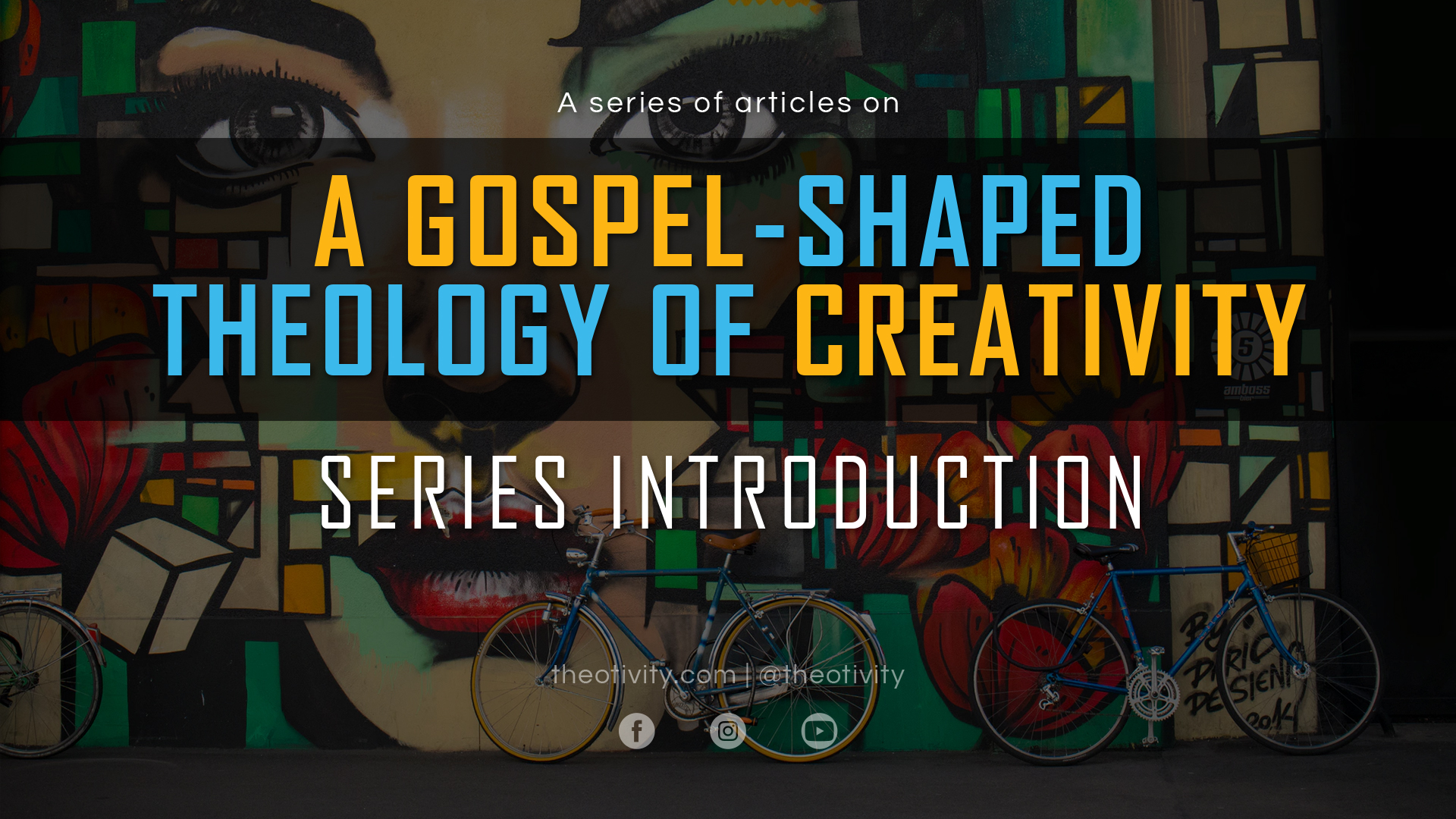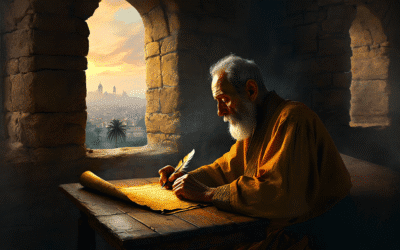You can listen to an audio version of the first 5 articles in this series here:
Perhaps you’ve cringed at a church bulletin that utilized every single font known to man – or maybe a flyer with cutting edge WordArt circa 1995… Or, maybe you’ve seen amazing and compelling graphics, sounds, and presence from movements and churches that were theologically dubious and wondered, where are the ‘solid’ Christian creatives? Does solid theology have to stifle creativity? Is there a place for creativity in the church? How do I glorify God as a creative person? These are some of the questions we will look at answering in this series of articles I’ve entitled “A Gospel-Shaped Theology of Creativity”.
The Goal of this series of articles
One of the goals of Theotivity is to help equip Christian creatives theologically to think through how their faith informs their creative talents and professional fields. The focus in this series will not be on giving an exhaustive list of examples of how to be creative in these areas, but rather giving you the theology which then drives, informs and compels creativity to the glory of God. It would be impossible to explore all of the implications of Christianity on creativity, but I hope to leave fruitful food for thought, and allow God, by His Spirit to use this in the hearts and minds of creatives to figure out how they can glorify Him with their gifts.
I must admit upfront that much of the content of these articles are gleaned from what I have learnt from other authors and I am indebted to their insights. Like I often say, I’m not actually smart. I’m second-hand smart… I just read smart people and assimilate their ideas! (Many of the books that were helpful to me will be linked throughout this series of artilces) However, I hope that this assimilation of theology about creativity would be helpful to you as it was to me. Ultimately, I want to help creatives connect the concept of ‘the Lordship of Christ’, which sometimes feels abstract, to every area of their life – even their creativity.
So, let’s get started with this series of articles by first taking a look at how we got to where we are today, what is a theology of creativity and what I mean by Gospel-shaped creativity.
How did we get here?

At one point, the church used to be a center of learning and training in art. Theology used to be a driving factor behind much of the great art that happened in the church. The growth of Christianity also was reflected, historically, with the growth of the creative arts as it gave new fuel to the imaginations of creatives who were captivated by the compelling beauty of the Gospel’s story. However, in recent times, the evangelical church, in particular, has not been exceptionally strong in leading the way for creatives to integrate their faith and creativity.
Theology was the driving factor behind Catholic Gothic architecture, for example, with its strong parallel lines leading the viewer’s eyes upward. Gothic churches were meant to make the viewer feel their smallness and thus communicate our place in a sacred space, as small creatures coming to an immense God. The theological message they were meant to communicate was undeniable.
The Reformation, Evangelicalism and Creativity
In contrast to Catholic sacramental theology, which emphasized the experiential (sometimes almost passive) participation in the various sacraments of the church as the primary means of grace, Protestant churches emphasized the preaching of the Word of God as the primary means of receiving the grace of the Gospel. This is the right emphasis and led to the Gospel explosion of the Reformation.
The Reformation even impacted the art of the day and many Reformers had developed a good theology of the right place of the arts, aesthetics and creativity. However, as Reformation theology spread and eventually led into evangelicalism, a strong theological basis for the arts and creativity was lost to pragmatism as tent revivals and the Great Awakening sought to separate even more from what it saw as “dead orthodoxy”. Beauty and the arts were often seen as ‘superfluous’ and unnecessary expense. This evangelical pragmatism even lingers today.

“Evangelicals have been legitimately criticized for often being so tremendously interested in seeing souls get saved and go to heaven that they have not cared much about the whole man. Yet , when a man comes under the blood of Christ , his whole capacity as man is refashioned. His soul is saved , yes , but so are his mind and body.” (Francis Schaeffer, Art and the Bible)
Many artists in evangelical churches today find themselves either feeling like there’s not much of a place for them at church. Or they feel that there isn’t any significant connection of their faith to their creative passions. Or perhaps they find themselves in a church that over-emphasizes experience and hype using the arts and creativity as man-made ways of attracting and entertaining people with a spectacle devoid of deep biblical-theological grounding.
Thus, we can see that there is a need for a theology of creativity. So, what is a theology of creativity and why is it important?
What is a “Theology of Creativity”?
A theology of creativity is simply a holistic look at scripture’s teachings on creativity, art, beauty and aesthetics in order to understand how it all fits into God’s big picture. Thomas Terry (who has been very helpful to me in this article series) is a spoken-word artist and founder of Humble Beast. He comments:

“I think one of the challenges with art in the church is a theological challenge, really. I think we have an issue with helping artists theologically think about their art. And so what ends up happening is artists in the church just learn to copy. Because they’re observing other people, because they don’t have a theology for it, so they just do what that person does… And so it just becomes really mundane, and boring, and uninspiring. But I think when you help them theologically to think about God and all of His complexities, the beauty of who God is, you touch the cosmos, you transcend this world, and it opens up your palate. It gives you colours that you never imagined. …And so we need to spend more time being inspired by things that resonate with who God is and testify of the kind of person God is, and His work, and His imprint on this beautiful world that we live in.” (Thomas Terry)

I think this is very true. Sadly, many evangelical churches that often emphasize the arts can also be deficient theologically in the life of the mind. Furthermore, Roman Catholic churches may have a lot of art, but often miss or obscure the Gospel – so the art can sometimes become idolatrous iconography. This can be true also of evangelical churches (in a different way) who idolize the arts – where exuberant worship, lights shows, comedy-drama skits and jokes become a replacement for the meat of the truth of God’s Word as the thing that keeps the pews filled. It almost seems like there is an impasse between theological depth and artistic passion and creativity. This should not be so.

Creativity and theology are not at odds with each other – but rather are vitally interconnected.
As David Covington notes: “…the same Bible that may have stirred our hearts to repent and believe the gospel also guides the stirring of our hearts in aesthetic pursuits. It means that the proper approach to aesthetics is itself God-centered.” (David Covington, A Redemptive Theology of Art, 24)
So, here’s the big question: How does the Gospel shape our creativity?
Gospel-Shaped Creativity

The Gospel is God’s big story of redemption through all of history.
“We love origin stories because we were made to love them. We love them because they cast light on our own search for meaning and purpose, which usually involves an extensive excavation of the past. We love them because we are temporal beings. Looking back comes natural to us… Knowing where we come from helps make sense of the life-giving questions about who we are and where we are going… philosopher and theologian Søren Kierkegaard said that ‘life can only be understood backwards, even while it must be lived forwards.’” (Thomas Terry & Ryan Lister, Images & Idols, 23)
I believe the Gospel shapes everything in the Christian’s life. It’s not just the entry point to the Christian life, it is every point of the Christian life. As such, I believe the Gospel also shapes our creativity, because the Gospel changes not just a part of our life, but the whole person – our whole life – including our creativity!
I’ll be using the familiar Gospel formulation as an outline for this series of articles:
GOD | MAN & SIN | CHRIST | RESPONSE
We’ll be looking at:
God as Creator | Man & Sin marred creativity | Christ redeemed creativity | Our Response
By first understanding our origins, with God as Creator, what went wrong with sin’s entrance to the world, and what God has done in Christ to solve that problem – only then can we respond appropriately.
So, I hope that you will join me on this theological journey towards forming a Gospel-shaped theology of creativity in the following articles in this series!
Please consider liking, commenting and/or sharing if you find these articles useful.
Articles in this series:



